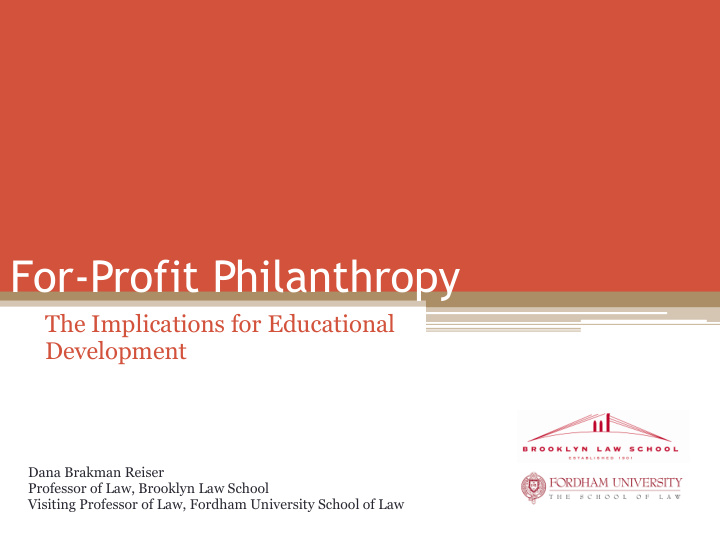



For-Profit Philanthropy The Implications for Educational Development Dana Brakman Reiser Professor of Law, Brooklyn Law School Visiting Professor of Law, Fordham University School of Law
For-Profit Philanthropy • Practices, players and norms native to the for- profit sector migrate into philanthropy ▫ Philanthropy LLCs ▫ Commercially-affiliated donor-advised fund sponsors ▫ Strategic corporate philanthropy
CZI: A Philanthropy LLC • Chan-Zuckerberg Initiative ▫ Created by Facebook Founder and CEO, Mark Zuckerberg, and his wife, Dr. Priscilla Chan ▫ To receive 99% of their net worth during their lifetimes ▫ Mission to “advanc[e] human potential and promote equality for all children in the next generation” • NOT a private foundation • Formed as limited liability company (LLC)
The Philanthropy LLC: Costs and Benefits • Costs ▫ Relative tax disadvantages ● Income, gift and estate tax costs can be minimized through planning • Benefits ▫ Privacy ▫ Control ▫ Flexibility ● Freedom from regulation ● Operational diversity
CZI Example: Operational diversity in the educational context • Grantmaking ▫ E.g., grants to two UC schools to support underrepresented students pursuing STEM careers ▫ Complete list of grants ● https://chanzuckerberg.com/grants-ventures/grants/ • Impact Investment ▫ Education focus A-Z ● https://chanzuckerberg.com/grants-ventures/ventures/ • Advocacy ▫ Core part of its tripartite approach, but little disclosure ● https://chanzuckerberg.com/about/our-approach/
Philanthropy LLCs: The Stakes for Society Potential Advantages Potential Disadvantages • More capital for social good • Crowding out • Efficiency gains ▫ Empirical question • Impact on broader business • Magnifying elite influence norms ▫ LLCs skirt transparency requirements and channeling effects of traditional philanthropy regulation
Donor-Advised Funds Explained • Donor makes contribution to sponsor ▫ Donor receives immediate tax deduction • Sponsor retains donated assets ▫ Donor can give instructions on investment ▫ Donor can give instructions on distribution ● Charitable recipients only ● Advising rights transferable on death • Largest U.S. sponsors affiliated with large investment companies (e.g., Fidelity, Schwab)
Donor-Advised Fund Facts & Figures • Over $110B in assets in 2017 • 2017 = banner year ▫ Contributions to donor-advised funds up 41% ▫ Number of accounts jumped by one-quarter ▫ Fidelity Charitable alone reported an 83% increase in donors and receipt of $8.5B in contributions • Commercially-affiliated DAF sponsors 4 of the top 10 recipients of charitable contributions in 2016 ▫ For 2017 list, Chron. of Phil. changed methodology of Philanthropy 100 to exclude DAFs, which had recently dominated it
Benefits for Donors • Privacy ▫ Grants are reported by DAF sponsor in aggregate • Control ▫ Donors retain advising powers, even through death • Flexibility ▫ Approximates private foundation benefits (e.g., control and endowment-building) without attendant regulatory load • PLUS, tax benefits (for itemizers) ▫ Current charitable deduction to public charity ▫ Double benefit for gifts of appreciated property
Implications of DAFs for Education • Transparency ▫ No fund-by-fund disclosure ● Providing another vehicle for educational mega-giving – outside spotlight • Channeling ▫ Asset-parking reduces funds available ● PPA 2006 study on aggregate payouts ● Foundation use of DAFs exacerbates concerns • Blowback ▫ Operating charities offering DAFs, often white-labeled ● Including prominently colleges and universities ▫ Competition changing community foundations
Thank you. Dana Brakman Reiser dana.brakman@brooklaw.edu Social Enterprise Law: Trust, Public Benefit, and Capital Markets (Oxford 2017) (with Steven A. Dean)
Recommend
More recommend